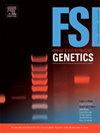一种多重细菌测定法,用于鉴定不同状态和混合染色的阴道液
IF 3.1
2区 医学
Q2 GENETICS & HEREDITY
引用次数: 0
摘要
准确鉴定阴道分泌液对法医调查至关重要,特别是在解决性侵犯案件时。体液特异性微生物群被认为是识别体液的潜在指标。在这项研究中,我们根据物种水平选择阴道核心细菌,并开发了一种多重PCR系统,用于鉴定不同个体状态和混合染色的阴道液。该系统使用一组350个样本(245个阴道样本和105个其他体液样本)进行验证。该系统显示出高灵敏度、抗抑制剂稳定性和强物种特异性,表明唾液和皮肤拭子不会被误认为阴道液。经血和阴道液的鉴定结果极为相似。对个体因素的进一步验证表明,该系统适用于来自不同地理区域、不同健康状况和不同性行为的女性个体的阴道样本。此外,该系统有效识别了所有模拟混合样本中的阴道液成分,并成功分析了实际性侵犯案件中年龄较大的阴道样本。总之,该多重PCR系统为阴道液的法医鉴定提供了一种很有前途的工具。本文章由计算机程序翻译,如有差异,请以英文原文为准。
A multiplex bacterial assay for identifying vaginal fluid in various individual states and mixture stains
Accurate identification of vaginal fluid is imperative for forensic investigations, particularly in resolving sexual assault cases. Body fluid-specific microbiota are considered potential indicators for identifying body fluids. In this study, we selected vaginal core bacteria based on species level and developed a multiplex PCR system for identifying vaginal fluid in various individual states and mixed stains. This system was validated using a set of 350 samples (245 vaginal samples and 105 other body fluid samples). The system demonstrated high sensitivity, stability against inhibitors, and strong species specificity, showing that saliva and skin swabs were not misidentified as vaginal fluid. Menstrual blood and vaginal fluid exhibited extremely similar identification results. Further validation of individual factors showed that the system was applicable to vaginal samples from female individuals across diverse geographical regions, with varying health statuses and sexual practices. Moreover, the system effectively identified vaginal fluid components in all simulated mixed samples and successfully analyzed aged vaginal samples from actual sexual assault cases. In conclusion, this multiplex PCR system provides a promising tool for the forensic identification of vaginal fluid.
求助全文
通过发布文献求助,成功后即可免费获取论文全文。
去求助
来源期刊
CiteScore
7.50
自引率
32.30%
发文量
132
审稿时长
11.3 weeks
期刊介绍:
Forensic Science International: Genetics is the premier journal in the field of Forensic Genetics. This branch of Forensic Science can be defined as the application of genetics to human and non-human material (in the sense of a science with the purpose of studying inherited characteristics for the analysis of inter- and intra-specific variations in populations) for the resolution of legal conflicts.
The scope of the journal includes:
Forensic applications of human polymorphism.
Testing of paternity and other family relationships, immigration cases, typing of biological stains and tissues from criminal casework, identification of human remains by DNA testing methodologies.
Description of human polymorphisms of forensic interest, with special interest in DNA polymorphisms.
Autosomal DNA polymorphisms, mini- and microsatellites (or short tandem repeats, STRs), single nucleotide polymorphisms (SNPs), X and Y chromosome polymorphisms, mtDNA polymorphisms, and any other type of DNA variation with potential forensic applications.
Non-human DNA polymorphisms for crime scene investigation.
Population genetics of human polymorphisms of forensic interest.
Population data, especially from DNA polymorphisms of interest for the solution of forensic problems.
DNA typing methodologies and strategies.
Biostatistical methods in forensic genetics.
Evaluation of DNA evidence in forensic problems (such as paternity or immigration cases, criminal casework, identification), classical and new statistical approaches.
Standards in forensic genetics.
Recommendations of regulatory bodies concerning methods, markers, interpretation or strategies or proposals for procedural or technical standards.
Quality control.
Quality control and quality assurance strategies, proficiency testing for DNA typing methodologies.
Criminal DNA databases.
Technical, legal and statistical issues.
General ethical and legal issues related to forensic genetics.

 求助内容:
求助内容: 应助结果提醒方式:
应助结果提醒方式:


